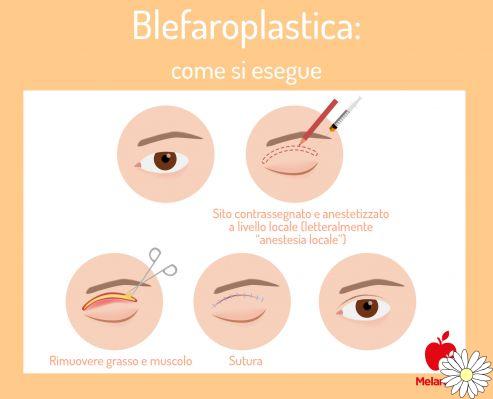La blepharoplasty is a surgical procedure used to reduce excess skin, muscles and fatty tissue. It is mainly performed for aesthetic purposes, but it can also be useful for improving vision.
In fact, when the eyelids are lowered, they cause a reduction in the visual field which can be dangerous as well as annoying.
Le eyelids, like other parts of our body, they are destined to age and lose elasticity, causing both their upper part to sag and the presence of bags under the eyes.
The intervention is very delicate and precise as it treats a thin layer of skin that is on the face, our calling card. The use of minimally invasive techniques and the preparation of expert hands, today make it a safe, effective procedure with few postoperative complications.
Blepharoplasty: what it is and characteristics
Blepharoplasty, or cosmetic eyelid surgery, is a surgical procedure. It consists in the elimination of excess skin and fat found in the upper and lower eyelids.
Hence, the two types of intervention: upper and lower blepharoplasty. The procedure also involves in some cases the repositioning of the drooping eyebrow.
Specifically, it can be used to correct numerous defects, such as:
- Blefarocalasi, i.e. an excess of epidermis of the upper eyelids associated with a loss of firmness.
- Eyelid ptosis, i.e. a weakening of the levator palpebrae muscle which reduces the possibility of opening the eye completely and can lead to visual disturbances.
- Bags of fat.
- eye bags.
- Entropion, that is, an inward tilting of the eyelashes which in contact with the cornea and conjunctiva causes inflammation.
- ectropion, i.e. the retraction of the lower eyelids that cause prolonged exposure of the cornea and conjunctiva with consequent inflammation.
As skin ages for everyone and gradually loses elasticity, theblepharoplasty plays a key role in facial rejuvenation and in the discovery of facial harmony. It is in fact one of the most commonly performed facial cosmetic surgery procedures.
It can be combined with other face and skin rejuvenation procedures, such as eyebrow or facial lifting, laser or resurfacing (a type of carbon dioxide laser also called CO2).

Categories
The most common blepharoplasty operations are upper and lower, but there is a third type which is the transconjunctival one.
Upper blepharoplasty consists inremoval of excess skin or accumulations of fat, said bags, right in the upper eyelid. The duration is about half an hour and can be performed under both local and general anesthesia.
La evaluation of fat pads and eyebrows it is important to redefine the superior sulcus, while looking at old photos of the patient can be useful for the surgeon to restore the youthful appearance.
Lower blepharoplasty it is a more complex intervention than the first. It too can be performed under local or general anesthesia, but the incision takes place in the sub-ciliary edge of the lower eyelid which is drooping. Through it, the surgeon can reshape the three bags of fat present (medial, central and lateral), the skin and the muscle.
The test that the specialist performs to determine the degree of skin laxity is called distraction test which is done by pulling the lower eyelid outward and downward. If its edge moves away from the eyeball more than 12mm, laxity is important.
Finally, transconjunctival blepharoplasty serves to eliminate bags under the eyes by making a small incision inside the conjunctiva of the lower eyelid.

How blepharoplasty is performed
Preparation for surgery
The blepharoplasty operation requires some phases ranging from the execution of tests to assess the patient's health status to the post-operative indications dictated by the specialist. Let's go into detail.
- The first thing to do if you want to undergo a blepharoplasty is a specialist visit to a plastic surgeon, who will provide all the necessary information relating to the type of intervention, what to expect, costs and examinations to be performed.
- In preparation for surgery, blood tests, electrocardiograms and eye examinations should be performed.
- On the day of the operation, we are fasted from solids and liquids, ready for anesthesia which can be local or general depending on the surgical plan, the patient's preferences and the need for other concomitant operations. A simple upper or lower eyelid blepharoplasty in which only the skin or fat is removed can be done under local anesthesia. Other more invasive procedures, such as lower blepharoplasty combined with fat repositioning, mid-face lift, or endoscopic brow lift may require intravenous sedation or general anesthesia.
Before starting, the surgeon draws the preoperative markings with a dermographic marker on the eyelids of the patient who must be seated correctly with a neutral gaze and the forehead well supported.
Operating room
In the operating room, the surgeon injects the eyelids to be operated with lidocaine to anesthetize the part. And then, it continues with the incision and the removal of fat and excess skin, as well as repositioning them if necessary.
Le incisions are made in the crease of the upper and lower eyelids and after a few weeks they are invisible.
The surgery ends with very fine points which are removed after 3-4 days.
At the end of the surgery, patients must start immediately with ice packs on the surgical site, to be continued for the next three days to reduce swelling and the application of an antibiotic ophthalmic cream to avoid infections.
For four weeks, you cannot expose yourself to the sun and you must always walk outside the house with sunglasses. Only make up your eyes after 10 days.
How long does the surgery last?
The expected time for an upper or lower blepharoplasty is about 1 or 2 hours, while the transconjunctival one takes much less, about 30 minutes.
Who is a good candidate for blepharoplasty?
The most suitable people to undergo this type of surgery are generally over thirty years old, who are in good health and above all who have no other eye diseases.
Instead, the doctor must be informed in case of:
- Diseases such as glaucoma, dry eye or retinal detachment.
- Disorders of the thyroid gland, such as Graves' disease.
- Cardiovascular diseases.
- Hypertension.
- Diabetes.
How many years does blepharoplasty last?
Blepharoplasty doesn't stop aging. However, i results usually last a long time. The upper eyelid surgery it can last over ten years, while the lower eyelid surgery it rarely has to be done more than once.
How long does the swelling last after blepharoplasty?
Swelling and bruising in the upper and lower eyelids is common after blepharoplasty.
The upper eyelids take about two weeks to look good, as they feature the incision line. Which does not happen with the lower eyelids.
To speed up the healing process it is important to rest, not go to work and limit activities. Some experience dry eyes, but after two weeks it should go away.
In case of persistence of the symptom, it is necessary to call the doctor.

Blepharoplasty: how much does it cost?
The cost of blepharoplasty depends on many factors, including:
- The surgeon's experience and fame.
- The name of the cosmetic surgery clinic you are addressing.
- Operating room in accordance with the law and safe.
- Excellent quality instrumentation.
- Medical prescription and therefore agreement with the SSN.
- Presence of a highly qualified surgical team.
- Technique chosen by the surgeon and the operand.
On average, the price is between 2 and 6 thousand euros, but it should be remembered that in cases of blepharoplasty for functional purposes (to be understood, the one made necessary for problems with sight) the intervention becomes loanable.

Are there any possible complications with blepharoplasty?
As with any surgical procedure, there is some degree of risk. Complications and bad results of blepharoplasty are rare, but they do occur sometimes.
Problems that can occur include:
- Bleeding.
- Infection.
- Dry eye.
- Abnormal discoloration of the eyelids.
- Folding in or out of the skin of the eyelids.
- Inability to close the eyes completely.
- Loss of vision, in severe cases.
As rare as they may be, it is important to be aware of potential complications before deciding to have surgery. However, it must be said that most patients have a very satisfactory result after the blepharoplasty procedure.


























